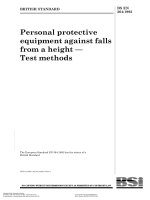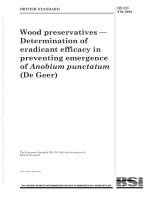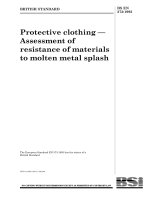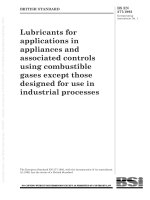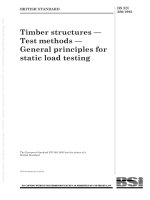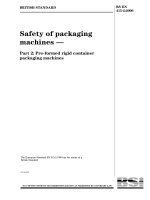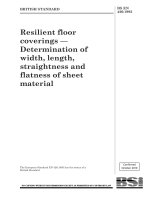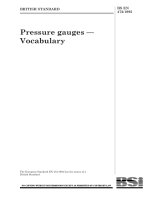Bsi bs en 61028 1993 (2000)
Bạn đang xem bản rút gọn của tài liệu. Xem và tải ngay bản đầy đủ của tài liệu tại đây (518.65 KB, 30 trang )
BRITISH STANDARD
Electrical measuring
instruments —
X-Y recorders
The European Standard EN 61028:1993 with the incorporation of
amendment A1:1995 and amendment A2:1997 has the status of a
British Standard
ICS 17.220.20
BS EN
61028:1993
Incorporating
Amendment No. 1 to
BS 7437:1991
(renumbers the BS as
BS EN 61028:1993)
and Amendments
Nos. 1 and 2 to
BS EN 61028:1993
BS EN 61028:1993
Committees responsible for this
British Standard
The preparation of this British Standard was entrusted by the Power Electrical
Engineering Standards Policy Committee (PEL/-) to Technical Committee
PEL/13, upon which the following bodies were represented:
Association of Consulting Engineers
Department of Energy (Electricity Division)
Department of Trade and Industry (National Physics Laboratory)
Electricity Association
The Association for the Instrumentation, Control and Automation Industry
GAMBICA (BEAMA Ltd.)
Institution of Electrical Engineers
Institution of Incorporated Executive Engineers
This British Standard, having
been prepared under the
direction of the Power
Electrical Engineering
Standards Policy Committee,
was published under the
authority of the Standards
Board and comes
into effect on
31 May 1991
Amendments issued since publication
Amd. No.
Date
Comments
© BSI 03-2000
7714
May 1993
Renumbers BS 7437 and adds Annex ZA
The following BSI references
relate to the work on this
standard:
Committee reference PEL/13
Draft for comment 86/24720 DC
8968
December
1995
10281
April 1999 Indicated by a sideline in the margin
ISBN 0 580 19613 5
BS EN 61028:1993
Contents
Committees responsible
National foreword
Foreword
1
Scope
2
Definitions
2.1 General terms
2.2 Description of recorders according to the number
of recording devices
2.3 Description of recorders according to their method
of marking
2.4 Constructional features
2.5 Characteristic features
2.6 Characteristic values
2.7 Influence quantity, reference conditions, nominal
range of use and preconditioning
2.8 Errors and variations
2.9 Accuracy, accuracy class and class index
3
Classification and compliance
3.1 Measuring class index
3.2 Compliance with the requirements of this Standard
4
Reference conditions and intrinsic errors
4.1 Reference conditions
4.2 Fiducial value and limits of intrinsic errors
4.3 Conditions for the determination of intrinsic error
4.4 Determination of the value of the dead band
4.5 Additional error term due to zero displacement
4.6 Orthogonality error
5
Nominal range of use and variations
5.1 Nominal range of use
5.2 Limits of variations
5.3 Conditions for the determination of variations
6
Further electrical and mechanical requirements
6.1 Dynamic performance
6.2 Continuous load
6.3 Permissible overloads
6.4 Limiting values of temperature
7
Constructional requirements
7.1 Sealing to prevent access
7.2 Preferred values for sensitivity
8
Information, markings and symbols
8.1 Information on the recorder
8.2 Information in documentation
8.3 Information relating to reference conditions and
nominal ranges of use
9
Markings and symbols for terminals
9.1 Requirements for markings
9.2 Earthing (grounding) terminals
9.3 Measuring circuit terminals
© BSI 03-2000
Page
Inside front cover
iii
2
3
3
3
4
4
4
7
8
8
9
9
10
10
10
10
10
10
12
12
13
13
13
13
13
14
14
14
16
16
16
17
17
17
17
17
17
17
20
20
20
20
i
BS EN 61028:1993
Page
Appendix A Determination of the influence of parasitic voltages
21
A.1 Common mode interference
21
A.2 Series mode interference
21
A.3 Statements as to the tests
22
Annex ZA (normative) Other international publications
quoted in this standard with the references of the relevant
European publications
22
Figure 1 — Determination of record-on and record-off delay times
16
Figure A.1 — Circuit diagram for the common mode test for one axis
21
Figure A.2 — Circuit diagram for the series mode test
21
Table I — Reference conditions and tolerances for testing
purposes relating to the influence quantities
11
Table II — Limits of the nominal range of use and permissible
variations
12
Table III — Examples of marking of reference value/range and
nominal range of use for temperature
18
Table IV — Symbols for marking recorders and their accessories
18
Publication(s) referred to
Inside back cover
ii
© BSI 03-2000
BS EN 61028:1993
National foreword
This British Standard has been prepared by Technical Committee PEL/85
(formerly PEL/13) and is the English language version of EN 61028:1993
including amendments A1:1995 + A2:1997. It is identical with IEC 61028:1991
including amendments 1 and 2.
The British Standards which implement international or European publications
referred to in this document may be found in the BSI Standards Catalogue under
the section entitled “International Standard Correspondence Index” or by using
the “Find” facility of the BSI Standards Electronic Catalogue.
A British Standard does not purport to include all the necessary provisions of a
contract. Users of British Standards are responsible for their correct application.
Compliance with a British Standard does not of itself confer immunity
from legal obligations.
Summary of pages
This document comprises a front cover, an inside front cover, pages i to iv,
the EN title page, pages 2 to 22, an inside back cover and a back cover.
This standard has been updated (see copyright date) and may have had
amendments incorporated. This will be indicated in the amendment table on the
inside front cover.
© BSI 03-2000
iii
iv
blank
EUROPEAN STANDARD
EN 61028
NORME EUROPÉENNE
January 1993
EUROPÄISCHE NORM
July 1995
+ A1
+ A2
November 1997
UDC 621.317.7
ICS 17.220.20
Descriptors: Measuring instrument, electrical measurement, recorder, indirect acting recorder, X-Y recorder
English version
Electrical measurement instruments — X-Y recorders
(Includes amendments A1:1995 + A2:1997)
(IEC 61028:1991 + A1:1995 + A2:1997)
Appareils électriques de mesure —
Enregistreurs X-Y
(Inclut les amendements A1:1995 + A2:1997)
(CEI 61028:1991 + A1:1995 + A2:1997)
Elektrische Meßgeräte —
X-Y-Schreiber
(Enthält Änderungen A1:1995 + A2:1997)
(IEC 61028:1991 + A1:1995 + A2:1997)
This European Standard was approved by CENELEC on 1992-12-09.
Amendment A1 was approved by CENELEC on 1995-07-04 and amendment
A2 on 1997-10-01. CENELEC members are bound to comply with the
CEN/CENELEC Internal Regulations which stipulate the conditions for giving
this European Standard the status of a national standard without any
alteration.
Up-to-date lists and bibliographical references concerning such national
standards may be obtained on application to the Central Secretariat or to any
CENELEC member.
This European Standard exists in three official versions (English, French,
German). A version in any other language made by translation under the
responsibility of a CENELEC member into its own language and notified to the
Central Secretariat has the same status as the official versions.
CENELEC members are the national electrotechnical committees of Austria,
Belgium, Denmark, Finland, France, Germany, Greece, Iceland, Ireland, Italy,
Luxembourg, Netherlands, Norway, Portugal, Spain, Sweden, Switzerland and
United Kingdom.
CENELEC
European Committee for Electrotechnical Standardization
Comité Européen de Normalisation Electrotechnique
Europäisches Komitee für Elektrotechnische Normung
Central Secretariat: rue de Stassart 35, B-1050 Brussels
© 1993 Copyright reserved to CENELEC members
Ref. No. EN 61028:1993 + A1:1995 + A2:1997 E
EN 61028:1993
Foreword
The CENELEC questionnaire procedure, performed
for finding out whether or not the International
Standard IEC 1028:1991 could be accepted without
textual changes, has shown that no common
modifications were necessary for the acceptance as
European Standard.
The reference document was submitted to the
CENELEC members for formal vote and was
approved by CENELEC as EN 61028
on 9 December 1992.
The following dates were fixed:
— latest date of publication
of an identical national
standard
— latest date of withdrawal
of conflicting standards
(dop) 1993-12-01
(dow) 1993-12-01
For products which have complied with the relevant
national standard before 1993-12-01, as shown by
the manufacturer or by a certification body, this
previous standard may continue to apply for
production until 1998-12-01.
Annexes designated “normative” are part of the
body of the standard. In this standard, Annex ZA is
normative.
For products which have complied with
EN 61028:1993 before 1996-04-01, as shown by the
manufacturer or by a certification body, this
previous standard may continue to apply for
production until 2001-04-01.
Foreword to amendment A2
The text of document 85/163/FDIS, future
amendment 2 to IEC 61028:1991, prepared by
IEC TC 85, Measuring equipment for
electromagnetic quantities, was submitted to the
IEC-CENELEC parallel vote and was approved by
CENELEC as amendment A2 to EN 61028:1993
on 1997-10-01.
The following dates were fixed:
— latest date by which the
amendment has to be
implemented at national
level by publication of an
identical national standard
or by endorsement
(dop) 1998-07-01
— latest date by which the
national standards
conflicting with the
amendment have to be
withdrawn
(dow) 1998-07-01
Endorsement notice
The text of the International Standard
IEC 1028:1991 was approved by CENELEC as a
European Standard without any modification.
Foreword to amendment A1
The text of document 85/42/DIS, future
Amendment 1 to IEC 1028:1991, prepared by
IEC TC 85, Measuring equipment for
electromagnetic quantities, was submitted to the
IEC-CENELEC parallel vote and was approved by
CENELEC as Amendment A1 to EN 61028:1993
on 1995-07-04.
The following dates were fixed:
— latest date by which the
amendment has to be
implemented at national
level by publication of an
identical national standard
or by endorsement
(dop) 1996-04-01
— latest date by which the
national standards
conflicting with the
amendment have to be
withdrawn
(dow) 1996-04-01
2
© BSI 03-2000
EN 61028:1993
1 Scope
This standard applies to X-Y recorders used for recording analogue electrical signals.
This standard specifies requirements for X-Y recorders, which can be used for the measurement of:
— a voltage or a current;
— another electrical quantity;
— a non-electrical quantity.
Recorders for measuring quantities other than voltage or current may contain a device for converting the
input quantity into a voltage or current. If the conversion device is interchangeable and removable, this
standard applies only to the recorder, provided that the conversion function is known.
This standard applies to recorders and their accessories having electronic devices in their measuring
and/or auxiliary circuit(s).
It also applies to non-interchangeable accessories and accessories of limited interchangeability
(e.g. shunts, impedance elements, etc.) when they are used with the recorder and adjustments have been
made for the combination.
This standard does not apply to X-t recorders. For X-Y recorders incorporating a time base, this standard
applies to the X-Y function only.
This standard does not apply to special purpose recorders which are covered by their own IEC standards.
This standard does not apply to special purpose devices nor to interchangeable accessories which are
covered by their own IEC standards when they are used as accessories.
For controllers with electrical outputs, containing electrical recorders this standard applies only to the
recorder and does not apply to the control circuit.
This standard does not contain requirements for protection against environmental conditions or the
relevant tests. If information is required on these aspects, reference should be made to IEC Publication 68.
This standard does not cover safety requirements. For further information, reference should be made to
IEC Publication 1010.
2 Definitions
The values of a.c. quantities given in this standard are r.m.s. values, unless otherwise stated.
For the purpose of this standard the following definitions apply.
2.1 General terms
2.1.1
recorder
a measuring instrument which records, on a recording medium, information corresponding to the values of
the measurand
NOTE 1 Some recorders may incorporate an indicating device.
NOTE 2 Some recorders may record information corresponding to more than one measurand.
NOTE 3 Some recorders may also include interchangeable plug-in units. In this case, the recorder may have different specifications
depending on the plug-in unit being used.
2.1.2
X-Y recorder
a recorder which traces the relationship between two or more analogue electrical signals as a continuous
line on two perpendicular axes of a chart
2.1.3 Accessory
An element, group of elements or device associated with the measuring circuit of a recorder in order to
confer specified characteristics on the recorder.
2.1.3.1
interchangeable accessory
an accessory having its own properties, class index or accuracy class these being independent of those of
the recorder with which it may be associated
© BSI 03-2000
3
EN 61028:1993
NOTE An accessory is considered to be interchangeable when its rated characteristics are known, marked and sufficient to enable
its errors and variations to be determined without using the associated recorder. For example, a shunt, whose adjustment takes into
account an instrument current which is not negligible and which is known, is considered to be interchangeable.
2.1.3.2
accessory of limited interchangeability
an accessory having its own properties and errors which can only be associated with recorders for which
certain characteristics are within specified limits
2.1.3.3
non-interchangeable accessory
an accessory adjusted to take into account the electrical characteristics of a specific recorder
2.1.4
distortion factor (total harmonic distortion factor of a quantity)
r.m.s value of the harmonic content
The ratio -------------------------------------------------------------------------------------------------------------------r.m.s value of the non-sinusoidal quantity
2.1.5
ripple factor
r.m.s value of the fluctuating component
The ratio ---------------------------------------------------------------------------------------------------------------value of the d.c. component
2.2 Description of recorders according to the number of recording devices
2.2.1
single recorder
a recorder having one recording device
2.2.2
multiple recorder
a recorder having more than one recording device and being able to record, simultaneously, different
quantities corresponding to different external signals
2.2.3
single-range recorder
a recorder having only one measuring range
2.2.4
multi-range recorder
a recorder having more than one measuring range
2.3 Description of recorders according to their method of marking
2.3.1
pen recorder
a recording instrument in which the record on the chart is made by a pen supplied with ink
(IEV 302-02-11.)
2.3.2
stylus recorder
a recording instrument in which the record on the chart is made by a stylus requiring no ink
(IEV 302-02-12.)
2.4 Constructional features
2.4.1 Measuring circuit (of a recorder)
The part of the electrical circuit internal to the recorder and its accessories, together with the
interconnecting leads, if any, which is energized by a voltage or a current, one or both of these quantities
being a prime factor in determining the recording of the measurand (one of these quantities may be the
recorded quantity itself).
4
© BSI 03-2000
EN 61028:1993
2.4.1.1
current circuit
a measuring circuit through which flows a current which is the prime factor in determining the recording
of the measurand
NOTE This may be the current directly involved in the recording or a proportional current supplied by an external current
transformer or derived from an external shunt.
2.4.1.2
voltage circuit
a measuring circuit to which is applied a voltage which is the prime factor in determining the recording of
the measurand
NOTE This may be the voltage directly involved in the recording or a proportional voltage supplied by an external voltage
transformer or an external voltage divider, or derived by means of an external series resistor (impedance element).
2.4.2
external measuring circuit
the part of the electrical circuit external to the recorder from which a measured value is obtained
2.4.3
auxiliary circuit
a circuit, other than the measuring circuit, required for the operation of the recorder
2.4.4
auxiliary supply
an auxiliary circuit providing electrical energy
2.4.5 Measuring element
The assembly of those parts of a recorder which are acted upon by a measurand, resulting in a movement
of the moving element related to that quantity.
2.4.5.1
indirect acting measuring element
the active part of a recorder which includes those parts whose interaction controls the servo-mechanism
2.4.5.2
servo-mechanism
an automatic control system in which the controlled variable is the mechanical position of the recording
device
NOTE
The action of the servo-mechanism is a function of the measurand and of the position of the recording device.
2.4.6
indicating device
the set of components which displays the value of a measurand or a related value
2.4.7
index
the fixed or movable part of an indicating device whose position with reference to the scale marks enables
an indicated value to be determined
2.4.8
scale
an ordered set of scale marks, together with any associated numbering, forming a part of an indicating
device
2.4.9
recording device
the set of components which records the value of a measurand or a related value
NOTE According to the method and kind of marking, it may comprise
— a pen associated with an ink supply, or
— a stylus.
© BSI 03-2000
5
EN 61028:1993
2.4.10 Zero and zero adjuster
2.4.10.1
zero (Electrical zero)
the record of a recorder when it is in use and with zero value of the measurand
2.4.10.2
zero scale mark
the mark on the scale or chart associated with the figure zero
2.4.10.3
zero adjuster
the device by means of which the recorder may be adjusted so that the zero (lower/upper limit of the
measuring range) coincides with the appropriate scale mark
2.4.10.4
recorder with zero displacement
a recorder which employs an additional device to change the position of the zero
2.4.10.5
zero displacement value
for a recorder with zero displacement, the value of the measurand expressed as a percentage of the effective
range (span), which corresponds to the difference between the indicated or recorded values with and
without the zero displacement, for the same value of the measurand
2.4.11
span vernier
a device which allows continuous fine adjustment of the sensitivity
2.4.12
record on/off control
a device by means of which the record may be enabled/disabled without interrupting the function of the
servo-mechanism
2.4.13
servo-release mechanism
the mechanism used to separate the recording device (e.g. pen) from the (pen drive) servo, to allow it to be
moved freely by hand
2.4.14
chart
a strip or sheet provided with or without chart lines and with or without numbering, from which are
obtained the values of the measurands, possibly by means of a reading rule
2.4.15
record
the line(s) made on the chart by the recording device of the recorder
2.4.16
chart lines
the series of pre-printed lines on the chart which enable the record to be interpreted
2.4.17
chart division
the interval between two adjacent chart lines
2.4.18
chart line numbering
the series of numbers designating the chart lines
6
© BSI 03-2000
EN 61028:1993
2.4.19
chart scale length
the length of the path traversed by the recording device between the extreme chart scale lines, when the
recording device is moved in the direction of one of the two axes
2.5 Characteristic features
2.5.1
span
the algebraic difference between the upper and lower limits of the measuring range. It is expressed in units
of the measurand
example: Measuring range – 10 V ... + 10 V; span = 20 V
2.5.2
measuring range
the set of values of a measurand within which the limits of error of a recorder are specified
NOTE
A recorder and/or its accessory can have several measuring ranges.
2.5.3
overshoot
the difference between the extreme recorded value and the steady recorded value when the measurand is
abruptly changed from one constant value to another by a specified amount
2.5.4 Dynamic performance
All the data which characterize the performance of a recorder when the measurand varies.
2.5.4.1
response time
the time interval between the instant when a stimulus is subjected to a specified abrupt change and the
instant when the response reaches and remains within specified limits of its final steady value
2.5.4.2
frequency response range
the range of frequencies of a sinusoidally varying measurand to which the recorder will respond within
specified limits relating to amplitude
2.5.4.3
phase difference response range
the range of frequencies of a sinusoidal measurand applied to both axes simultanously to which the
recorder will respond within specified limits relating to phase difference
2.5.4.4
maximum acceleration
maximum value of acceleration of the recording device when it responds to a step input on one axis
2.5.4.5
slewing speed
maximum speed which the recording device reaches when it is moved along one of the axes
2.5.4.6
sensitivity
the change in the response of a recorder divided by the corresponding change in the input quantity
NOTE
The reciprocal of this is commonly used (measurand divided by response).
2.5.4.7
dead band
the range through which a measurand may be varied without producing a change in the record
2.5.5
impedance of the external measuring circuit (source impedance)
the impedance of the external measuring circuit as seen from the input terminals of the recorder
© BSI 03-2000
7
EN 61028:1993
2.5.6
impedance of the internal measuring circuit (input impedance)
the impedance of the internal measuring circuit as seen from the input terminals of the recorder
2.5.7 Parasitic voltages
2.5.7.1
common mode voltage (between measuring circuit and earth)
that part of the input voltages, for which the amplitude and either the phase or the polarity are the same,
which exists between each of the input terminals and a reference point
NOTE
This reference point may be the frame terminal or the measuring earth terminal, or it may be an inaccessible point.
2.5.7.2
series mode voltage (series voltage)
an unwanted part of the input voltage which is superimposed on the voltage initiated by the measurand
NOTE
Typical examples of a series mode voltage are induced voltages, an a.c. ripple on a d.c. signal, or thermopotentials.
2.6 Characteristic values
2.6.1
nominal value
a value of a quantity indicating the intended use of a recorder or an accessory
NOTE 1 The intended characteristics of recorders and accessories are also nominal values.
NOTE 2 The nominal value may be a rounded value of the characteristic concerned and is often an appropriate value of the quantity
reproduced by a measurement standard.
2.6.2
rated value
a value of a quantity assigned, generally by the manufacturer, for a set of specified operating conditions
2.6.3
fiducial value
a clearly specified value of a quantity to which the error(s) of a recorder and/or an accessory are referred in
order to specify their respective accuracies
NOTE
This value can, for example, be the upper limit of the measuring range, the span or another clearly stated value.
2.7 Influence quantity, reference conditions, nominal range of use and preconditioning
2.7.1
influence quantity
a quantity which is not the subject of the measurement but which influences the value of the record
for example: humidity, ambient temperature, frequency of a measured voltage
2.7.2 Reference conditions
Conditions of use for a recorder prescribed for performance testing, or to ensure valid comparison of results
of measurements.
NOTE
Reference conditions generally specify reference values or reference ranges for the influence quantities affecting the recorder.
2.7.2.1
reference value
a specified value of one of a set of reference conditions
2.7.2.2
reference range
a specified range of values of one of a set of reference conditions
2.7.3
nominal range of use
a specified range of values which an influence quantity may assume without causing a variation exceeding
specified limits
8
© BSI 03-2000
EN 61028:1993
2.7.4
limiting values of an influence quantity
extreme values which an influence quantity can assume without the recorder or accessory being damaged
or permanently altered in such a way that it no longer meets the requirements of its accuracy class
NOTE
The limiting values may depend on the duration of their application.
2.7.5
preconditioning
the action whereby, under reference conditions, a specified value of the measurand is applied to the
measuring circuit prior to carrying out testing or use of the recorder or accessory
2.7.6
preliminary adjustments
adjustments, specified by the manufacturer, that must be made before using the recorder so that it will
operate with specified accuracy
2.8 Errors and variations
NOTE The concept of error is limited to those errors determined when the recorder is under reference conditions. This concept of
error is concerned with the intrinsic qualities of the recorder in contradistinction to the variation in the record which may arise from
the use of the recorder under conditions other than the reference conditions.
2.8.1
absolute error
for a recorder, the value obtained by subtracting the conventional true value from the recorded value
for an accessory, the value obtained by subtracting the conventional true value from the rated value
NOTE 1 Since the true value cannot be obtained by measurement, a value obtained under specified test conditions and at a specified
time is used instead. This value is derived from national measurement standards or reference measurement standards agreed upon
by manufacturer and user.
NOTE 2 “Absolute error”, which has a sign, should not be confused with “absolute value of an error” which is the modulus of an error.
NOTE 3 When a recorder is used together with an accessory, the error of such a combination is calculated by taking the algebraic
sum of the errors of the recorder and the accessory.
NOTE 4 In practice, the error of measurement can only be determined with some uncertainty.
2.8.2
intrinsic error
the error of a recorder and/or its accessory when under reference conditions
2.8.3 Variation
The difference between the two recorded values for the same value of the measurand when a single
influence quantity assumes successively two different specified values within the nominal range of use.
2.8.3.1
additional error term due to zero displacement expressed as a percentage of the zero
displacement
one hundred times the difference between the specified value and the measured value of the displacement,
divided by the specified value of the displacement
2.8.3.2
errors (variations) expressed as a percentage of the fiducial value
one hundred times the ratio of the absolute error (variation) to the fiducial value
2.9 Accuracy, accuracy class and class index
2.9.1
accuracy
the ability of a recorder to provide a record approaching the conventional true value of a measurand
for an accessory, the closeness of the marked value to the conventional true value
NOTE
The accuracy of a recorder or of an accessory is defined by the limits of intrinsic error and by the limits of variations.
© BSI 03-2000
9
EN 61028:1993
2.9.2
accuracy class
a group of recorders and/or accessories which meets certain metrological requirements intended to keep
errors and variations within specified limits
NOTE
An accuracy class shall be indicated for each axis.
2.9.3
class index
the number which designates the accuracy class
NOTE
Some recorders and/or accessories may have more than one class index.
3 Classification and compliance
3.1 Class index
Recorders satisfying this Standard are classified according to their accuracy class related to the measurand
for each of the axes.
Accuracy class indices shall be selected from a 1 – 1.5 – 2 – 2.5 – 3 – 5 sequence or their decimal
submultiples.
3.2 Compliance with the requirements of this Standard
Recorders and accessories shall comply with the relevant requirements of this standard relating to their
accuracy class or class indices.
If, for the determination of intrinsic errors and variations, preconditioning is specified, the manufacturer
shall state the preconditioning period and all other relevant conditions.
Recorders and their accessories shall be adequately packed to ensure that, after transport under normal
conditions, they comply with the requirements of this standard.
4 Reference conditions and intrinsic errors
4.1 Reference conditions
The recorder shall be put into operation according to the specifications of the manufacturer.
The reference conditions of the influence quantities shall be as given in Table I unless otherwise stated.
The reference value for the ambient temperature shall be specified by the manufacturer and shall be
selected from 20 °C, 23 °C or 27 °C in accordance with IEC Publication 160.
Reference conditions different from those given in Table I may be specified.
4.2 Fiducial value and limits of intrinsic errors
When the recorder, together with its non-interchangeable accessory(ies) (if any), is under the reference
conditions given in Table I and is used between the limits of its measuring range and in accordance with
the manufacturer’s instructions, the intrinsic error, expressed as a percentage of the fiducial value, shall
not exceed the limits appropriate to its accuracy class. Values stated in a table of corrections supplied with
the recorder shall not be taken into account in determining the errors.
NOTE 1 The intrinsic error includes other error components such as those due to dead band, amplifier drift, etc.
NOTE 2 However, for multi-range recorders, the manufacturer may, in addition to the class index, state a value of the maximum
absolute error (expressed e.g. in microvolts).
4.2.1 Correspondence between intrinsic error and accuracy class
The maximum permissible error is related to the accuracy class such that the class index is used as the
limit of error, expressed as a percentage with positive and negative signs.
NOTE
For example, for a class index of 0.05, the limits of intrinsic error are ± 0.05 % of the fiducial value.
4.2.2 The fiducial value for the measurand corresponds to the span. For zero displacement, the fiducial
value corresponds to the nominal value of zero displacement.
10
© BSI 03-2000
EN 61028:1993
Table I — Reference conditions and tolerances for testing purposes
relating to the influence quantities
Influencing quantity
Tolerances permitted for testing
purposes, applicable for a single
reference value
Reference conditions unless
otherwise stated
Ambient temperature
See Sub-clause 4.1
± 2 °C
Relative humidity
40 % to 60 %
—
Position
Supporting plane horizontal
± 5°
Ripple of d.c. measurand
Zero
1%
Distortion of a.c. measurand
Distortion factor to be stated by the manufacturer
Frequency of a.c. measurand
To be stated by the manufacturer ± 1 %
Magnetic field of external origin
Total absence
40 A/ma at frequencies from zero
to 65 Hz in any direction
Electric field of external origin
Total absence
1 kV/m at frequencies from zero
to 65 Hz in any direction
Auxiliary
supply
Parasitic
voltages
Voltage
Nominal value or nominal range
to be stated by manufacturer
± 1 % of nominal value
Frequency
Nominal value or nominal range
to be stated by manufacturer
± 1 % of nominal value
Series mode voltage,
Zero
a.c. or d.c.
Common mode
voltage, a.c. or d.c.
Zero
Impedance of external
measuring circuits
To be stated by the manufacturer
Chart
To be stated by the manufacturer
Recording device
(recording means)
To be stated by the manufacturer
1 % of the values indicated
in Table II for the nominal range
of use
NOTE These tolerances apply when a single reference value is specified in this table or is marked by the manufacturer. For a
reference range, no tolerance is allowed.
a
40 A/m is approximately the highest value of the earth’s magnetic field.
© BSI 03-2000
11
EN 61028:1993
Table II — Limits of the nominal range of use and permissible variations
Influence quantity
Permissible variation
expressed as a percentage
of the class index
Limits of the nominal range of use
unless otherwise stated
Ambient temperature
Reference temperature ± 10 °C
100
Relative humidity
25 % and 75 %
100
Position
± 10° from the reference position
(or reference range if any)
100
Ripple of d.c. measurand
To be stated by the manufacturer
Distortion of a.c. measurand
To be stated by the manufacturer
Frequency of a.c. measurand
To be stated by the manufacturer
Magnetic field of external origin
See Sub-clause 5.2.1
Voltage
Auxiliary
supply
Frequency
100
Reference value ± 10 % or lower
limit of reference range – 10 %
and upper limit of reference
range + 10 %
50
Reference value ± 5 % or lower
limit of reference range – 5 % and
upper limit of reference
range + 5 %
50
Series mode voltage,
Parasitic a.c. or d.c.
To be stated by the manufacturer 100
voltage Common mode voltage,
a.c. or d.c.
Impedance of external
measuring circuits
To be stated by the manufacturer 100
4.3 Conditions for the determination of intrinsic error
The preconditioning period should normally be 30 min and should not be more than 2 h for convenience.
The errors shall be determined for increasing and decreasing values of the measurand. All the values of the
errors shall be within the limits specified.
The recorded value of the measurand is read from the chart. If the value is read from chart lines, an
appropriate correction shall be made to take account of the accuracy of the distances of the chart lines.
The determination of intrinsic error shall be carried out as follows:
a) Single-range recorder
The measurand shall be applied to the recorder under test and to a reference instrument and
progressively changed in such a way as to avoid overshoot until the required value is reached on the
reference instrument. The test is carried out for each axis separately.
NOTE
This method was chosen because it takes better account of automatic calibrators which are preferred for recorder testing.
b) Multi-range recorder
The determination of errors shall be carried out in the same manner as for single-range recorders but
by using first one of the ranges and then, successively, the others, including repeated preconditioning
where specified.
NOTE The reason for this repeated preconditioning is that the total impedance of the circuit may vary when changing the measuring
range and, in consequence, the offset voltage compensation of an input amplifier may change.
4.4 Determination of the value of the dead band
The following method is recommended in order to determine the dead band at a given point in the
measuring range.
12
© BSI 03-2000
EN 61028:1993
The starting point corresponds to a value of the measurand smaller than the chosen value by an amount
equivalent to five times the class index. The measurand is slowly increased until the chosen value is read
on the reference instrument and the recorded value is then noted. The same operations are then repeated,
starting at a value greater than the chosen value by an amount equivalent to at least five times the class
index and decreasing the measurand. The difference between the two values noted is the value of the dead
band [see explanatory note to 4.3 a)].
4.4.1 Maximum value of the dead band
Under reference conditions, the dead band is included within the intrinsic error.
The dead band may exceed the value corresponding to the permissible error when one (and only one)
influence quantity is within its normal range of use, all the other influence quantities being at their
reference values or within their reference ranges. This increase in the value of the dead band shall not
exceed the permissible variation for that influence quantity.
4.5 Additional error term due to zero displacement
The limits of the additional error shall have a value not exceeding 100 % of the class index. Only a lower
value may be specified by the manufacturer.
4.6 Orthogonality error
This test is carried out by recording straight lines for each axis independently on the same chart over the
full scale length, and by measuring the maximum gap between the Y-axis trace and a datum line which
intersects the X-axis precisely at right angles. The gap (error) expressed as a percentage of the scale length
shall be within the value specified by the manufacturer.
5 Nominal range of use and variations
5.1 Nominal range of use
5.1.1 The limits of the nominal range of use for influence quantities shall be as given in Table II.
5.1.2 When a manufacturer specifies a nominal range of use which is different from that shown in
Table II, the range shall include the reference range (or reference value with permitted tolerances) and
normally exceed it in at least one direction.
5.1.2.1 For values of the nominal range of use beyond the reference range (or reference value), the variation
shall not exceed the values given in Table II.
5.1.2.2 When an influence quantity is not one of those shown in Table II, the value of the influence quantity
and the resultant variation shall be stated by the manufacturer. The variation shall not exceed 100 % of
the class index.
5.1.2.3 Mutual influence between the different circuits of a multiple recorder
The variation arising from a mutual influence between the different measuring circuits is determined by
energizing one measuring circuit so that a deflection equal to & of the scale length corresponding to the
measuring range is obtained and by changing the measurand of each of the other measuring circuits
between the limits of their measuring range under the most unfavourable phase or polarity conditions. The
variation of the first measuring circuit is recorded. The test is repeated, in turn, on every measuring circuit.
The variation shall not exceed 50 % of the class index.
5.2 Limits of variations
When a recorder or an accessory is under reference conditions and a single influence quantity is varied, the
variation shall not exceed the values given in Table II and in Sub-clauses 5.1.2.2 and 5.1.2.3. The variation
includes the thickening of the trace.
5.2.1 Variation due to a magnetic field of external origin
5.2.1.1 When a recorder is not marked with Symbol F-30 (Table IV) and no relevant information is given
in the documentation, the magnetic field strength shall be 0.4 kA/m at mains frequency.
5.2.1.2 For recorders marked with Symbol F-30 (Table IV), or with relevant information in the
documentation, the magnetic field strength at mains frequency shall have a value, expressed in
kiloamperes per metre (kA/m), as given in the symbol or documentation.
© BSI 03-2000
13
EN 61028:1993
5.2.1.3 The test procedure is as follows:
The test for variation due to a magnetic field of external origin is carried out using all orientations of the
magnetic field and using alternating current at the mains supply frequency to produce the magnetic field.
The field should be produced by a coil having a mean diameter not less than 4 times the maximum
dimension of the recorder. The current shall be such as to produce a magnetic field of 0.4 kA/m in the centre
of the coil in the absence of the recorder to be tested.
Under the conditions of Sub-clauses 5.2.1.1 and 5.2.1.2, the variation shall not exceed the limits given
in Table II. The test shall be carried out for each axis separately under the most unfavourable conditions.
5.2.2 Variation due to parasitic voltages
NOTE
The influence of parasitic voltages shall be determined by the methods given in Appendix A.
5.2.2.1 The manufacturer shall state the values of the parasitic voltages for which the variation does not
exceed a value corresponding to 100 % of the class index. Parasitic voltages may be limited by safety
requirements.
The influence of parasitic voltages shall be stated for:
— common mode interference;
— series mode interference.
5.2.2.2 The common mode test is made with a direct voltage and with an alternating voltage at mains
frequency.
The series mode test for recorders measuring d.c. quantities is made with an a.c. voltage having a frequency
equal to the mains frequency and also to twice this value.
The alternating parasitic voltages shall be derived from the mains supply to the recorder. The phase
relationship between the mains voltage and the parasitic voltages shall be so adjusted as to obtain the
maximum influence. For recorders measuring a.c. quantities, the series mode voltage is a d.c. voltage.
The manufacturer may state the interference for any other frequency of parasitic voltage.
5.2.2.3 The earthing (grounding) conditions, including connections with the internal screen, if any, shall be
those stated by the manufacturer. If there is no earth terminal, the manufacturer shall state which
conductive part of the recorder may be used as an earthing (grounding) point.
5.3 Conditions for the determination of variations
5.3.1 The variations shall be determined for each influence quantity shown in Table II.
5.3.2 For preconditioning see Sub-clause 4.3.
5.3.3 The variations shall be determined for each influence quantity and for each axis separately.
During each test all influence quantities shall be maintained at their reference conditions except for the
influence quantity for which the variation is to be determined.
5.3.3.1 When a reference value is given, the influence quantity shall be varied between that value and any
value within the limits of the nominal range of use as given in Table II unless otherwise specified.
5.3.3.2 When an influence quantity has a reference range, it shall be varied from each limit of the reference
range to the adjacent limit of the nominal range of use.
5.3.3.3 The determination of variations associated with the influence quantities shall be made
between 40 % and 60 % of the span.
6 Further electrical and mechanical requirements
6.1 Dynamic performance
The recorder shall be under reference conditions, the auxiliary circuits being energized. The impedance of
the external measuring circuit shall have a steady value between the limits stated by the manufacturer.
The amplifier gain or the attenuation, if any, shall be set as specified by the manufacturer.
14
© BSI 03-2000
